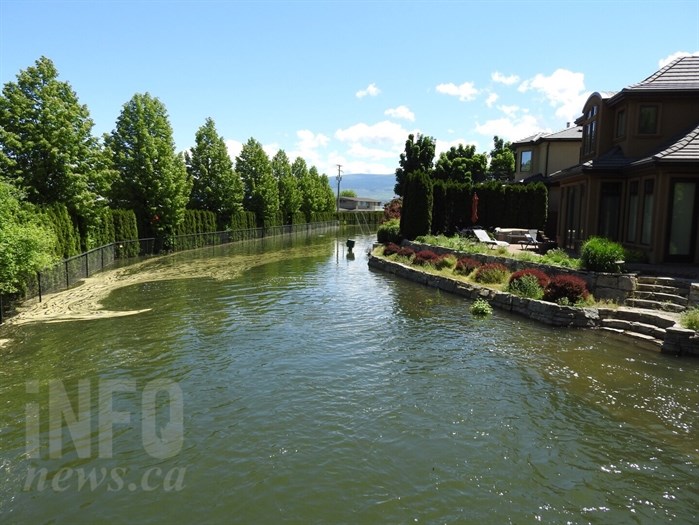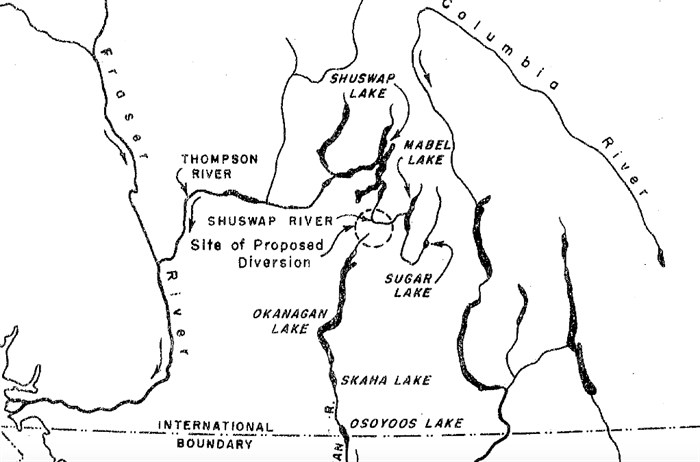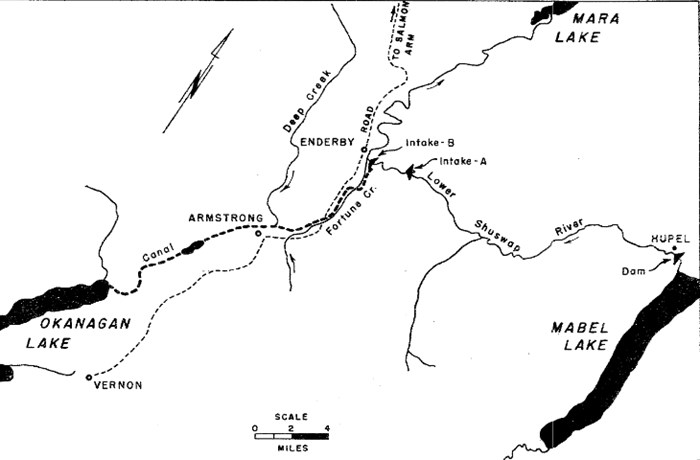
A canal was once proposed to connect Okanagan Lake to the Shuswap River. This one is at Green Bay in West Kelowna.
(JENNA HICKMAN / iNFOnews.ca)
December 12, 2020 - 7:30 AM
It will take many more years before those pushing for a rail trail from Sicamous to Osoyoos will see their dreams come true.
But, before there were rail lines into Kelowna, there was a dream to build a canal to connect the Shuswap River with Okanagan Lake – a dream that was revisited in the 1960s.
On the other hand, if there had not been a railway, the idea for a canal may never have been hatched in the first place.
It all seems to have started in 1874 when a railway engineer named Marcus Smith discovered that he could travel the 18 miles between Okanagan Lake and what was then called the Spallumcheen River by canoe through a series of ponds and swamps.
That’s according to Salmon Arm historian, environmentalist and columnist, Jim Cooperman.
The idea was picked up by such luminaries as Preston Bennett, a Spallumcheen farmer and member of the provincial legislature, Vernon based government agent Moses Lumby (after whom Lumby was named) and rancher Thomas Wolfe.
In 1882, railway engineer L.B. Hamlin was told to take a break from overseeing the construction of the Canadian Pacific Rail line to survey the route, according to Cooperman’s article.
He determined that four or five locks would be needed and it would cost $27,000 per mile to build. Instead, the Shuswap and Okanagan Railway, also championed by Lumby, opened in 1891 at a cost of about $4,000 a mile.

Image Credit: Submitted/B.C. Government
That might have just been a forgotten footnote in B.C.’s history if the idea hadn’t been revived again in the 1960s, this time as a way to increase the supply of water in Okanagan Lake for irrigation.
The project was proposed by Premier W.A.C. Bennett to be funded by a $6 million agricultural fund, Cooperman wrote.
This time the idea was studied extensively by federal and provincial government staff, culminating in a 1969 study called the “Report on the Fisheries Problems associated with the Proposed Diversion of water from Shuswap River to Okanagan Lake.
The earlier studies had looked at the impact on salmon in the Okanagan River south of Skaha Lake but had not considered the trout and salmon stocks in the Shuswap River.
The report is full of detailed charts on projected population growth, water needed for irrigation along with water flows and temperatures. It also details the layout of the proposed canal.

Image Credit: Submitted/B.C. Government
The earlier study had contemplated a dam near Mabel Lake that would raise the lake level by about 12.5 feet and suggested the lake could be drawn down by as much as 7.8 feet below its normal minimum level under extreme conditions.
That, of course, would block access to the lake by spawning fish without the construction of an expensive and complicated fish ladder.
Dams near Enderby would raise the river level by as much as 35 feet and, again, make it difficult for the fish to travel.
A weir would also have had to be built to keep the fish from traveling into the Okanagan.
Plus, drawing water from Shuswap River in the summer for farmers in the Okanagan could virtually dry out the river bed in drought years.
The report, which seems to have hammered the final nail in the canal’s coffin, suggested it would make more sense to take water from Sugar Lake in winter months to refill Okanagan Lake. But, another study on the impact on fish between Enderby and Sugar Lake would have to be done.
It seems like that was the end of the story for water travel between the two lake systems.
Now, it’s just a matter of time until the funds can be raised to complete the Rail Trail on that old rail line from Sicamous to Armstrong, and eventually connect to other trails down to the U.S. border and beyond.
READ MORE: We are so close to a rail trail connecting Osoyoos to Sicamous
To contact a reporter for this story, email Rob Munro or call 250-808-0143 or email the editor. You can also submit photos, videos or news tips to the newsroom and be entered to win a monthly prize draw.
We welcome your comments and opinions on our stories but play nice. We won't censor or delete comments unless they contain off-topic statements or links, unnecessary vulgarity, false facts, spam or obviously fake profiles. If you have any concerns about what you see in comments, email the editor in the link above.
News from © iNFOnews, 2020